Introduction
Working on complex integration of software products in a larger solution landscape requires a combination of technical skills, project management and collaboration.
In the article, we will explore practical insights and actionable tips that transcend the theoretical, ensuring you gain a tangible understanding of the subject matter. So, whether you are a developer, project manager or business executive, fasten your seatbelt for an enlightening exploration of ways to conquer complexity in the world of integration products.
As businesses increasingly rely on interconnected solutions, mastering the art of handling complex integration products becomes paramount. In this introductory chapter, we set the stage for a deep dive into effective approaches and proven methods that will empower you to address the challenges of integration with confidence.
Understanding complex integration products
The complexity of integration products arises from several key components:
- Diversity of integrated systems: Each system has its own architecture, data formats and communication protocols.
- Data variability: Inconsistent data sources, formats, quality and volume.
- Real-time requirements: immediate data synchronisation and processing.
- Interdependencies: Changes in one component may impact others.
- Security concerns: Exchange of sensitive or personal data between systems, ensuring data security, confidentiality and compliance with regulations.
- Scalability demands: As business grows, integration products must scale to accommodate increased data loads and user interactions.
- Legacy systems integration: Incorporating legacy systems with outdated technologies into modern integration solutions.
- Continuous changes: Adapting while ensuring system stability.
- Cross-organisational collaboration: Collaboration between different departments, teams or even external partners.
- Monitoring and maintenance: Proactively addressing issues, optimising performance and ensuring the sustained functionality of the integrated systems.
Understanding and navigating these key components are crucial for developing effective strategies to handle the complexity of integration products successfully.
Complex integration fundamentals
By combining technical expertise with effective communication and project management skills, you can manage the challenges of working on complex integration products successfully:
- Always start by clearly defining integration needs, understand the data flows, system dependencies and the overall objectives of the integration. This foundational understanding is the prerequisite for a successful project.
- Deep understanding of the technologies involved, such as APIs, protocols, middleware and databases is the next step. Staying updated on the latest industry standards and integration best practices ensures a current and informed approach.
- Architecture design plays a pivotal role. Crafting a scalable architecture with focus on data security, performance and fault tolerance lays the groundwork for a robust integration solution.
- API design should prioritise simplicity, consistency and usability.
- Well balanced documentation for developers ensures a smooth integration process.
- Testing strategies, including unit, integration and end-to-end testing, are essential. Automated testing tools further enhance reliability.
- Monitoring and logging mechanisms, implemented with tools like the Elasticsearch, are vital for tracking integration performance.
- Security measures, encompassing encryption, authentication and authorisation, safeguard sensitive information.
- Effective collaboration and communication are non-negotiable. Maintaining clear communication channels with stakeholders and regularly updating project documentation foster a transparent and well-informed project environment.
- Knowledge sharing within the team is very important. Regular sessions and reviews are used to broaden the skill sets of team members.
- And last, but not the least, adopting agile project management approach facilitates adaptability and continuous improvement. Breaking down tasks into manageable sprints with defined goals ensures a structured and iterative development process.
The benefits of applying agile methodologies to complex integration projects lie in their iterative and adaptive approaches. Iterative development allows for incremental progress, enabling quick adjustments based on evolving requirements. The adaptive nature of agile accommodates changes during the integration process, fostering flexibility and responsiveness. This results in enhanced collaboration, faster delivery of integrated solutions and improved ability to address evolving business needs with agility.
Do you need a common backend
The concept of a common backend layer in IT environments addresses the need for a centralised and standardised foundation that can support various applications and services within an organisation. It supports consistency, interoperability, cost efficiency and adaptability, ultimately contributing to the overall success of an IT organisation.
In a complex IT environment, a common backend layer is crucial when dealing with diverse applications that require seamless interaction, ensuring standardised communication, data consistency and streamlined integration. It becomes necessary when multiple applications need access to shared data, providing a centralised repository to avoid silos. For consistent business logic across applications, a common backend layer reduces redundancy and promotes uniformity. Unified security measures, such as authentication and authorisation, are efficiently managed through a centralised backend. In environments with varying scalability and performance demands, a shared backend is designed to handle challenges and optimise performance. Additionally, a common backend layer supports system decoupling in interconnected yet independent systems.
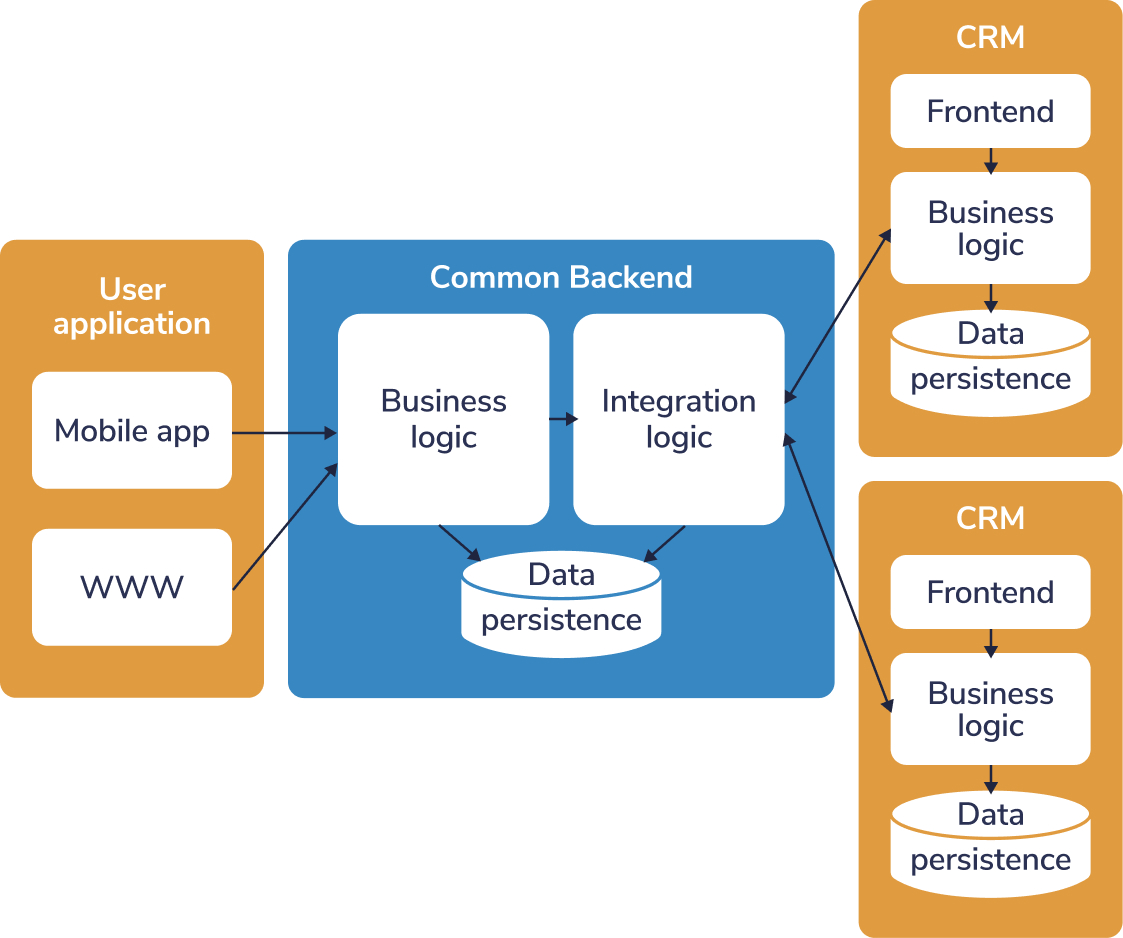
Illustration: Common backend example (arrows represent data creation/update flow)
Sprinting has vast experience in building common backends. You can also deep dive into digital transformations with common backends in this blog post.
Alternatively, a common backend layer might not be needed in a complex IT environment with highly specialised applications operating independently, minimal integration needs or in cases of fully centralised systems, where the overhead of a shared backend may not be justified.
The need for a common backend layer in an IT environment can also be the result of a certain top management strategy. It can be the late recognition of the value of integration, short-term focus over long-term planning, lack of strategic alignment or simply the need for fast reaction for market business demands.
Collaboration among cross-functional teams, thorough planning and a commitment to ongoing improvement are key to building and maintaining an effective common backend layer for the integration of multiple solutions across a large landscape.
Effective project documentation
Effective project documentation is the backbone of successful integration products, providing a roadmap for teams to navigate the complexities of their tasks. However, when project documentation falls out of sync with the evolving dynamics of a project, it introduces a lot of challenges that can jeopardise success. In this context, outdated project documentation poses a range of obstacles, from miscommunication and errors to difficulties in tracking progress and ensuring accountability.
Balancing comprehensive project documentation in agile projects requires a strategic approach to avoid bottlenecks. Therefore, the best approach is to prioritise concise and living documentation, utilising user stories and collaborative tools, establish clear documentation standards and assign ownership to team members closest to the information. Documentation should be treated as a byproduct of work, integrating it seamlessly into the workflow.
While agile approach strongly advocates a minimalist approach, prioritising working software over comprehensive documentation, it does not negate the significance of capturing crucial information throughout the product’s lifecycle. In essence, agile documentation seeks to include only the most vital details necessary for effective project support, bypassing unnecessary bureaucracy. The emphasis lies on maintaining a balance, ensuring that documentation remains lean yet robust, containing essential information relevant to the product’s lifetime.
Here is an example of the consequences when documentation falls out of sync. The illustrations below showcase updates made to the product in subsequent releases, with added or modified sections highlighted in orange.
The first illustration demonstrates the ideal scenario, where the product is well-supported by documentation for each release.
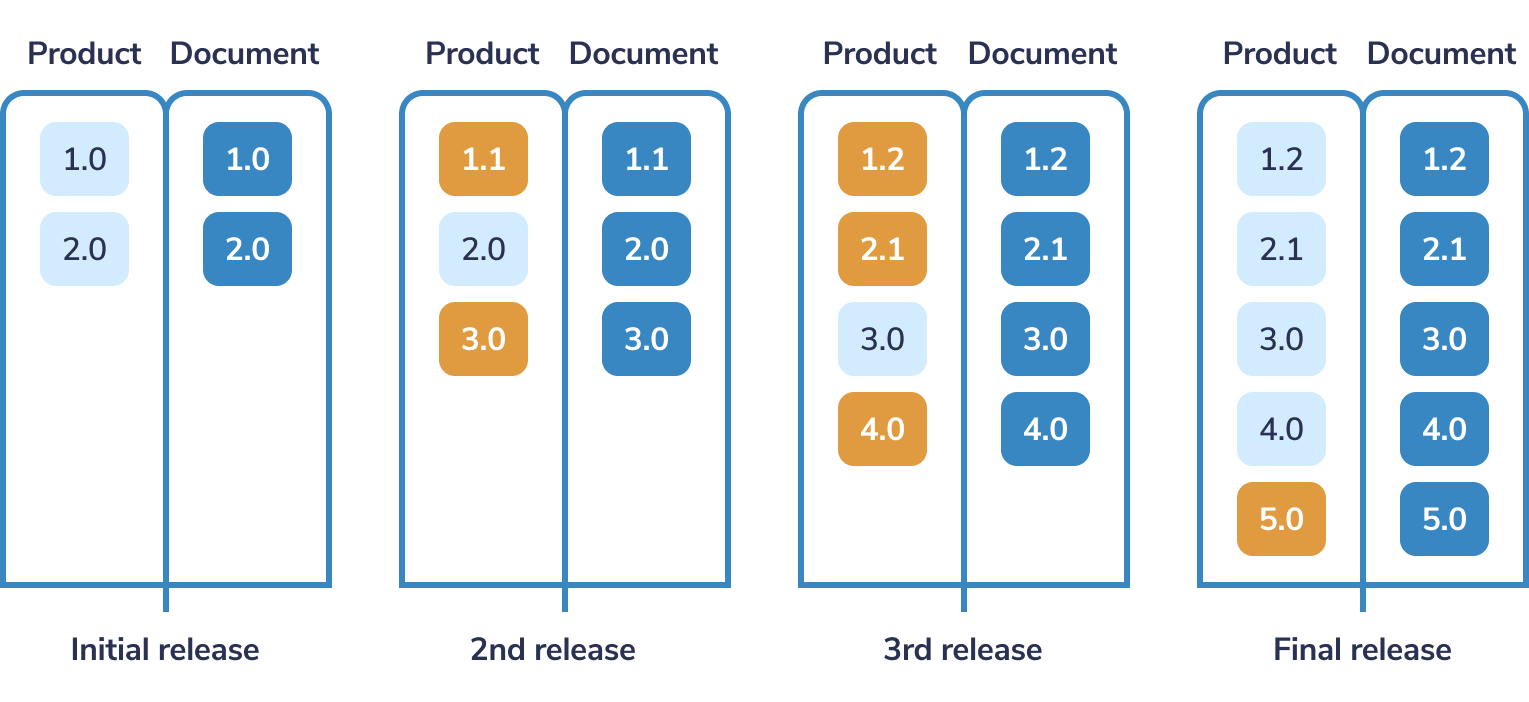
Illustration: Documentation produced as a natural byproduct of ongoing project work
Now, let us assume the project team neglects updating the documentation after the second release. This will lead to an outcome that some documentation sections (highlighted in red) may contain inaccurate information or may not be documented at all.
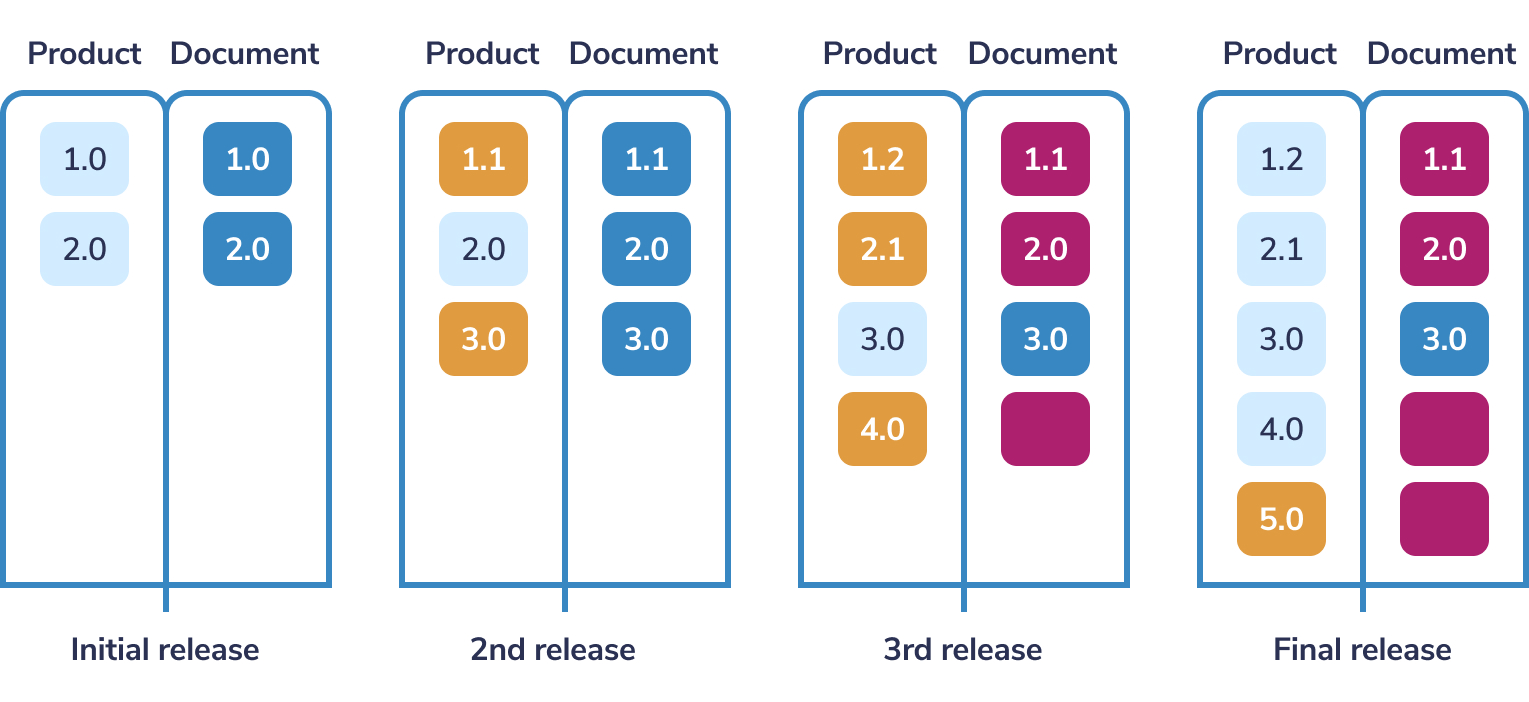
Illustration: Documentation update is not consistent throughout the project lifecycle
Finally, there is a risk of infrequent updates to the documentation after the initial release. Often, updates are consolidated with the final release for handover purposes. This practice can lead to some technical updates during interim releases being inadequately documented, potentially causing confusion among stakeholders.
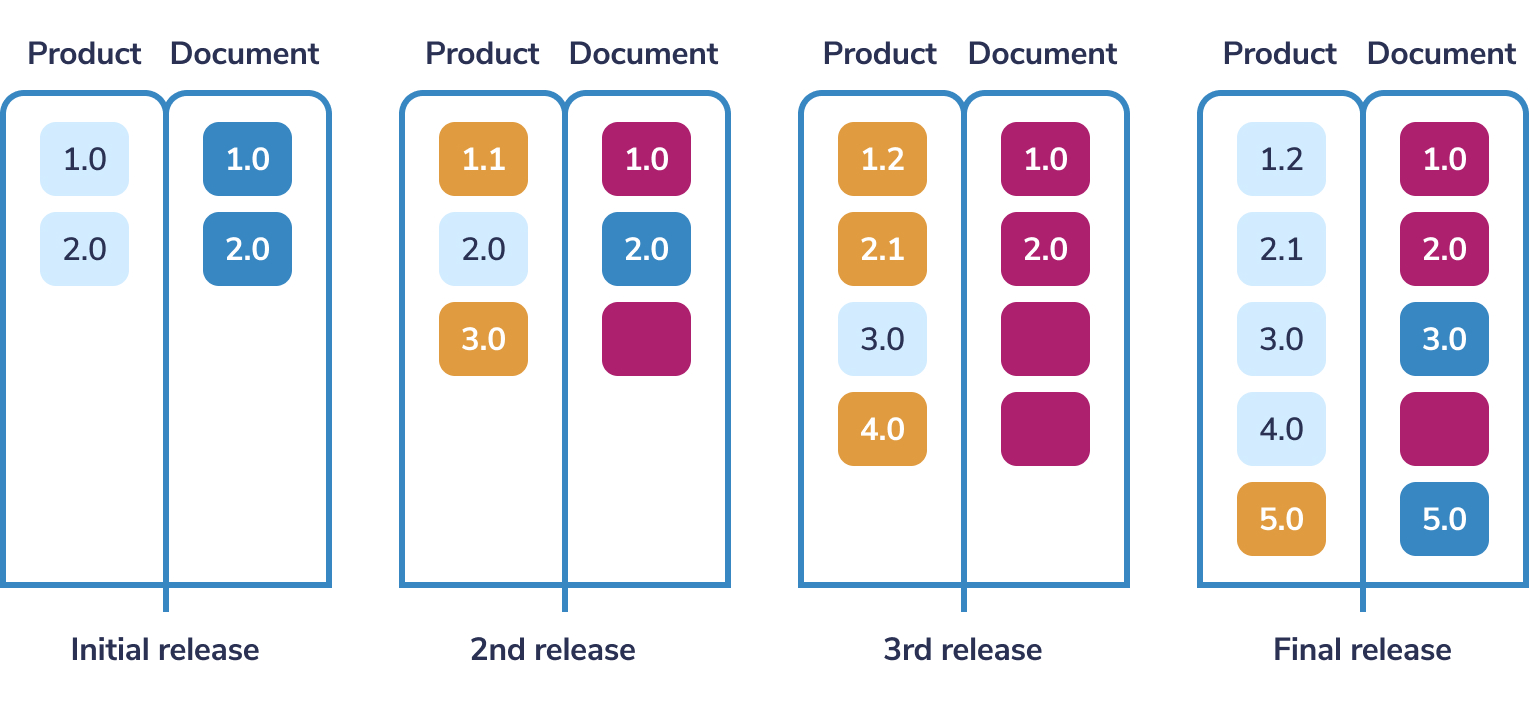
Illustration: Initial documentation supplemented by updates during the handover phase
Let us explore some challenges that may arise when project documentation is not up to date and practical mitigations to address these issues:
Miscommunication and misalignment:
- Challenge: Outdated documentation can lead to miscommunication and misunderstandings among team members, stakeholders and other project participants.
- Mitigation: Regularly update and communicate changes in project documentation to ensure everyone is on the same page. Implement a communication strategy to keep all stakeholders informed.
Impacts decision-making:
- Challenge: Outdated documentation can lead to uninformed decision-making as key stakeholders may not have access to the most recent information.
- Mitigation: Ensure that decision-makers have access to the latest documentation. Encourage a decision-making process that involves cross-referencing multiple sources to validate information.
Increased project delays:
- Challenge: Outdated documentation may result in delays as team members waste time trying to decipher or confirm information.
- Mitigation: Maintain an organised and accessible document repository. Implement a change management process to update documentation promptly and efficiently.
Knowledge transfer challenges:
- Challenge: When documentation is not up to date, knowledge transfer becomes difficult during team transitions or handovers.
- Mitigation: Document critical knowledge and processes consistently. Provide training and onboarding for new team members, emphasising the importance of keeping documentation current.
Difficulty in continuous Improvement:
- Challenge: Outdated documentation hinders the identification of areas for improvement in project processes.
- Mitigation: Foster a culture of continuous improvement by regularly reviewing and updating project documentation. Encourage team members to provide feedback and suggest improvements.
Addressing these challenges requires a proactive approach to documentation management, including regular reviews, effective communication and the establishment of clear processes for updating and maintaining project documentation.
Managing changes
Managing changes in complex integration products involves systematically handling modifications, updates or additions to the integrated systems. This process begins with the identification of the need for change, whether prompted by new requirements, improvements or bug fixes. Subsequently, an impact analysis is conducted to assess how the proposed change will affect the integration ecosystem, taking into account potential risks, dependencies and areas that might be impacted.
Change planning follows, wherein a plan is developed outlining the steps required for implementing the change. The next step involves thorough testing and validation of the proposed changes in a controlled environment to ensure they do not negatively impact existing functionalities. The changes are validated against the integration requirements.
Transparent communication with stakeholders and collaboration among teams involved in the integration are crucial for successful change management, especially in complex integration scenarios. Comprehensive documentation of the integration architecture, configurations and changes made should be maintained, providing a valuable resource for troubleshooting, auditing and future reference.
Establishing change control board
When a product reaches a certain level of maturity, it is recommended to establish one-hour weekly approval sessions, called Change control boards, to sustain/improve processes and review important changes in an integrated environment. In order to have integration processes in place, it is important to define strategic and operational goals, including mandatory participants and effective agenda for the change control board.
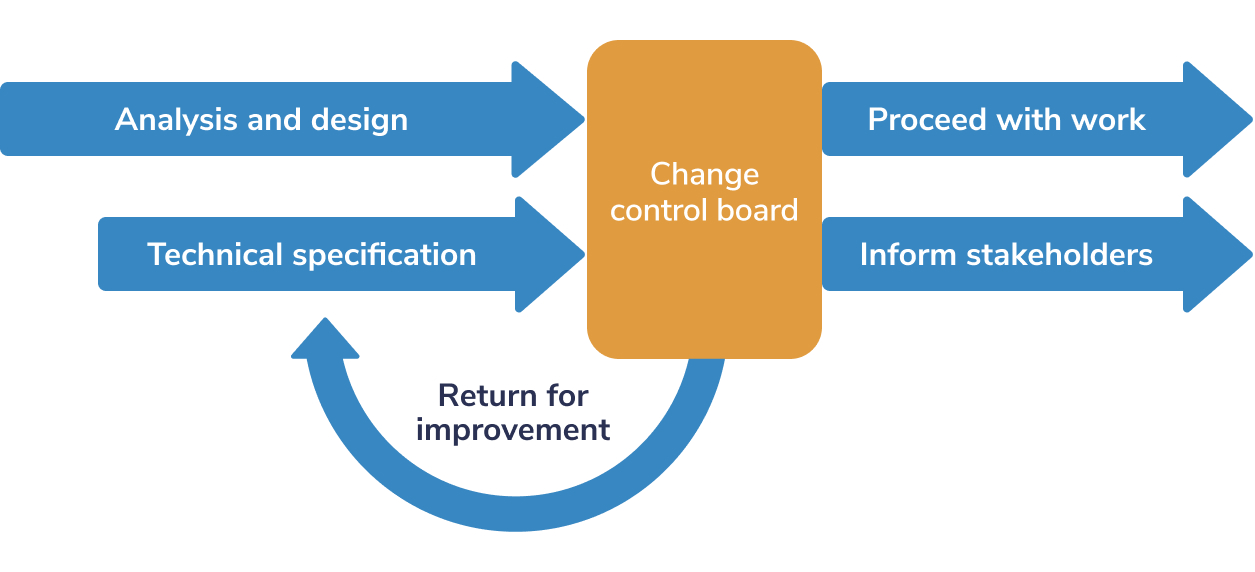
lllustration: Change control board – process example
Let us define above mentioned process in more details:
Strategic goals
- Optimise and harmonise integration processes
- Define effective decision-making process and clear ownership
- Be in line with the strategy defined by key stakeholders
- Retain agility and efficiency, in parallel with setting up stronger change management process
- Maintain up-to-date architectural and process diagrams of system dependencies and ownerships
- Identify and eliminate redundant and inefficient processes
- Ensure trust among all participants in the process
Operational goals
- Define members for change control boards, including experienced moderator
- Product owners
- Solution architects
- Technical and project leaders
- Define structure for Request for Change (RfC) document. For example:
- Objectives
- Design summary
- Alternatives
- Timeline
- Dependencies
- Security/privacy/compliance
- Risks
- Create detailed minutes, including action owners
- In case of high-priority matters:
- Set up extraordinary change control board
- Set up Fast-track approval process
- Utilise a veto mechanism to prevent quality reduction
- Establish follow-up for approved and realised changes
- Find effective alternatives, if possible
- Avoid bottlenecks
- Establish sustainable and transparent release management process
Change control board agenda
- Evaluate nominated RfC documents and define next steps
- Discuss architectural improvements and integration topics
Conclusion
In the exploration of complex integration products, our journey began with a foundational understanding of complex integration and its fundamentals, emphasising the sophisticated nature of blending diverse elements into a cohesive whole.
This concept, underscored by the recognition of the importance of effective project documentation, provides a roadmap for organisations aiming to master the complexities inherent in integration projects.
As we examined the challenges associated with managing changes, we acknowledged the dynamic nature of integration landscapes. Successful integration relies on an organisation’s ability to adapt to evolving requirements, necessitating robust change management practices.
The establishment of a change control board emerged as a pivotal strategy. This collaborative space not only fosters communication but also acts as a crucible for the refinement of strategic and operational goals. It becomes a melting pot where ideas, insights and expertise converge to shape the trajectory of integration initiatives.
Understanding, adaptability, documentation, collaboration and goal alignment converge to form the bedrock of successful integration endeavours. As organisations navigate this sophisticated landscape, the lessons learned from these key aspects will undoubtedly shape a future where complex integration is not just a challenge to overcome but an opportunity to innovate and thrive.



